
32 minute read
DRC FOCUS
A major energy t ransit ion
The global energy companies’ shift towards greener sources of power comes as a blow for oil-rich African countries. What’s good for the goose is not good for the gander
Advertisement
By PIERRE-OLIVIER ROUAUD
On the continent, Total, Shell and Eni are prioritising their gas developments. But their projects in renewable energies and carbon offsetting are still modest. This focus on gas is good news for some environmentalists, but bad news for African oil-producing countries that
Senegal’s Grand Tortue Ahmeyim LNG project
benefit from the tax revenue and jobs that come from oil.
Under pressure from public opinion and Western regulators, but also from their shareholders and financial partners, the oil sector’s majors, and especially the European ones – Shell, BP, Total and Eni – have begun an unprecedented change: their voluntary and gradual withdrawal from the extraction of crude oil in favour of ‘greener’ energies. Shell’s CEO Ben van Beurden has said that the Dutch-British group’s oil production peaked in 2019 and is now declining by 1% to 2% per year.
The stated goal of many oil majors, supported by the European Union and the United Kingdom, is ‘carbon neutrality’ by 2050. The European majors have no legal obligations at this stage, but they have set this target for all their activities, including the final use of the fuels they sell – which is by far the most important factor in carbon emissions. For example, Total’s direct emissions amount to about 45m tonnes of CO2 equivalent, but
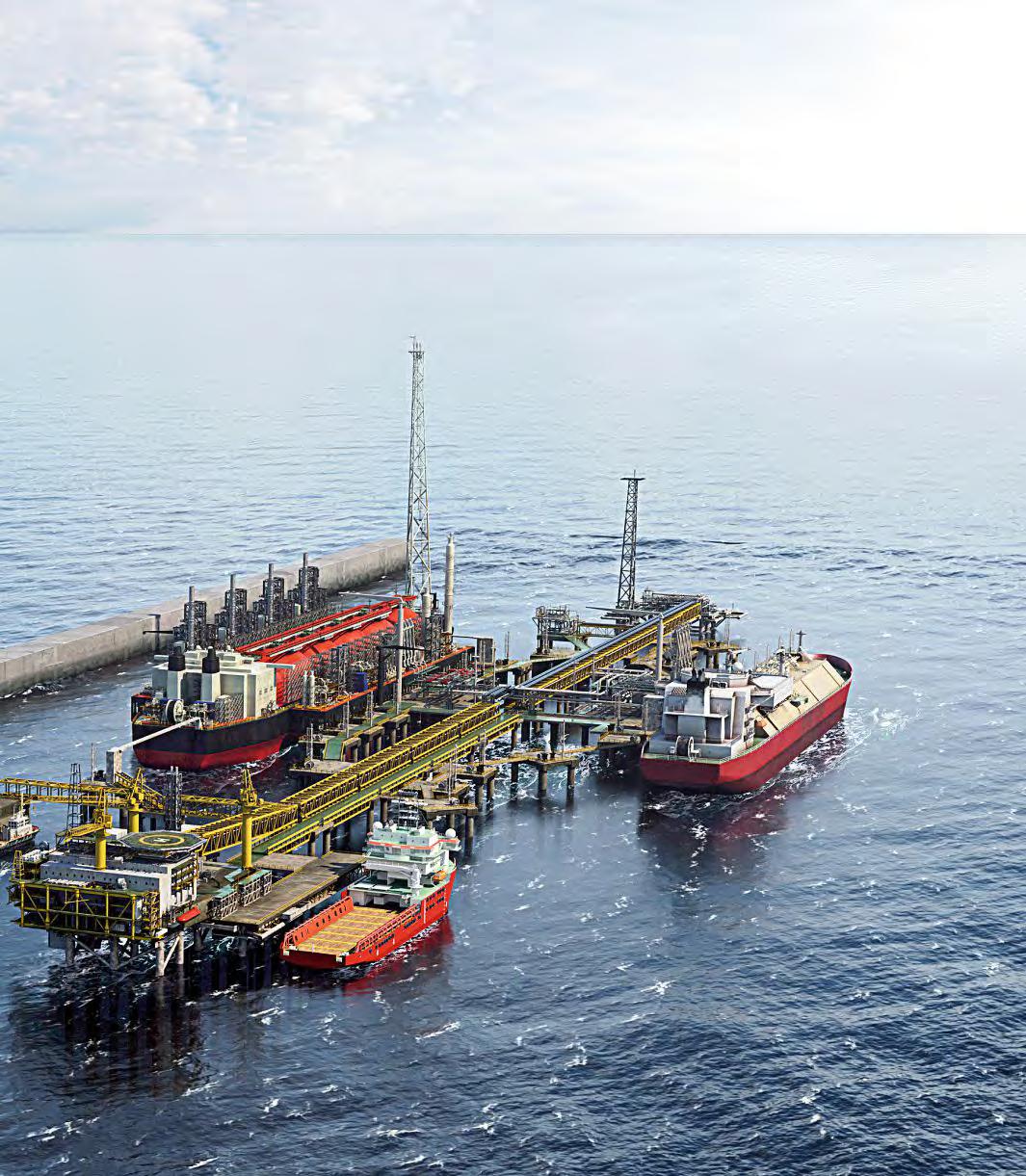
the group estimates those related to vehicle fuel at 450m tonnes.
In the global negotiations on CO2 emissions, the continent is more of a spectator than a player. It generates 9% of the world’s liquid petroleum (oil) production (7.2m barrels per day) and 6% of natural gas production. But it remains a modest emitter of greenhouse gases: with 17% of the world’s population, Africa accounts for only 2% of emissions.
SHARE OF INSTALLED RENEWABLE AND FOSSIL FUEL GENERATION CAPACITY IN AFRICA BY REGION IN 2019
Bubble size based on total installed capacity in the respective region
Renewable energy
Fossil fuels & nuclear
107,928 MW
No appetite for new projects
Half of Africa’s oil production is exported. However, when it comes to energy, the priority for Africa’s governments is first and foremost to improve access to it for their populations: 600 million people still lack electricity, and the massive use of biomass has devastating effects on health and the environment.
The road to energy transition for the European majors will be long. A small consolation for their managers is that the US giants Exxon and Chevron – which are both less present on the continent than the Europeans and less convinced of the risks linked to climate change – and the Chinese companies CNOOC and Sinopec are much further behind.
For the African national oil companies, energy transition is not their concern: their goal is to optimise the exploitation of hydrocarbon resources, of which they hold a large part of the continent’s reserves. Energy transition is a Western concept designed to solve a Western problem.
The African deposits that have already been exploited should easily find investors, even if they are no longer led by the majors. In Nigeria, for example, Shell, Total and Eni recently sold 45% of the offshore OML 17 field to billionaire Tony Elumelu for $1.1bn. The risk for African countries from the sudden focus on energy transition is that developments will slow down. Jonathan Evans, BP’s director of new African projects, stated during Africa Oil Week, at the end of 2020, that, due to the carbon-emission constraints, BP will launch very few oil extraction projects on the continent.
This trend is all the more pronounced since the majors’ Western financial partners are now more reluctant to invest in large extractive projects. Barclays and Credit Suisse have announced that they will cease financing the East African Crude Oil Pipeline in Uganda and Tanzania, which would have allowed Total and CNOOC to develop their Lake Albert fields.
“Development agencies and even multilateral donors are increasingly reluctant to finance fossil-fuel projects, even gas,” says Stéphane His, senior consultant at the French research firm Enerdata.
48,289
35,754
22,668
Natural gas Coal Hydropower Diesel & fuel oil
7,234 5,753 1,940 1,626 830
SOURCE: IRENA
Solar Wind Nuclear Bioenergy Geothermal
PRIMARY ENERGY DEMAND IN AFRICA
Renewables Natural gas Oil Coal Biomass
2%
45% 16%
SOURCE: IEA
23%
13%
Green and mean
The policy is not to everyone’s taste. Cameroonian lawyer NJ Ayuk, president of the African Energy Chamber, denounces the “demonisation” of the sector and the “anti-African” attitude of Western governments and environmental organisations like Greenpeace. An example of their influence is the recent decision of the British government’s foreign credit agency UK Export Finance (UKEF) to no longer support gas projects in Mozambique.
In this context, how are the European majors reducing their carbon footprints in Africa? In addition to ‘operational efficiency’ (reducing methane leaks from wells or ending flaring and optimising well drilling), their plans are based
Egypt’s Zohr giant offshore gas field
around three strategies: gas, renewables, and nature-based carbonoffset projects.
On the continent, if the majors are backing off from oil, they are pushing hard for gas with tens of billions of dollars in projects. “On a global level, the majors are switching over. Most of them already derive half of their revenue from gas,” says His. The reason is well-known: coal was used for 37% of the world’s electricity generation in 2019. Replacing it with gas would cut global CO2 emissions in half.
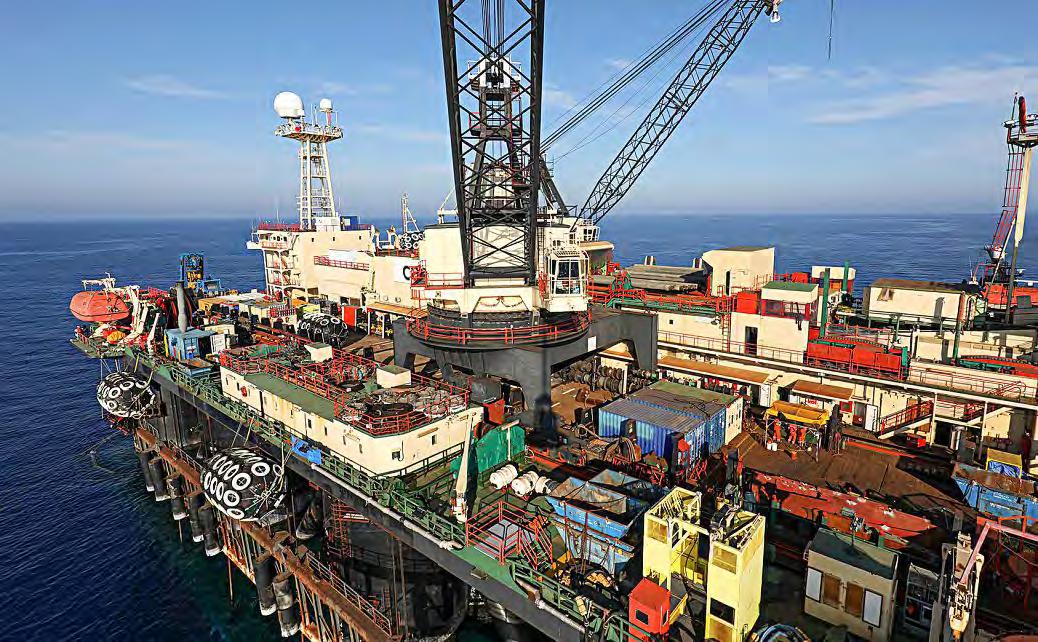
It’s a gas, gas, gas!
Gas is the ‘transitional energy’ touted by Patrick Pouyanné, Total’s CEO. This vision is strongly contested by environmental NGOs, which point out that gas production is still polluting, that it emits CO2 and that it is not a renewable energy.
On the continent, while continuing to work in countries with a long experience in the gas sector, such as Algeria, the majors have established themselves in new production countries where major discoveries have been made. In Egypt, Eni has changed the country’s energy landscape with the giant Zohr field.
Mozambique has three gas megaprojects totalling more than $55bn in planned investments. But the largest of these, Mozambique LNG, was suspended by Total following the attack on the nearby town of Palma at the end of March. The second project on the list, Rovuma LNG, led by Eni with the support of ExxonMobil, is still awaiting the final go-ahead.
In West Africa, Shell (25%) and Total (15%) are leading a $4bn investment in a seventh LNG processing unit on Nigeria’s Bonny Island with the semi-public group NLNG. In Senegal and Mauritania, the offshore Grand Tortue Ahmeyim (GTA) field, led by BP in partnership with the explorer Kosmos, is expected to produce its first gas in 2023 and to boost the economies of those two countries. Finally, in Angola, Chevron, Eni (operator), Total and BP, together with Sonangol, are currently developing a $12bn integrated liquefied natural gas (LNG) project in Soyo.
While the gas equation relies mainly on exports to developed countries or major emerging markets (such as China), the good news for Africa is that it can benefit local electrification projects.
This is the case in Mozambique and Senegal with the GTA project, which is intended to supply several power plants. In Ghana, Shell has just invested in the Tema LNG terminal, which will make the country the very first south of the Sahara to import LNG. Total expects to do the same in Côte d’Ivoire and Benin. In Angola, the future Soyo terminal will supply a 750MW power plant. For the governments of these countries, the preoccupations of Western companies with reducing their carbon footprint could not be further from their minds.
$55bn
Combined planned investment in Mozambique’s three gas megaprojects: Mozambique LNG, Rovuma and Coral
ENVIRONMENT
Green shoots
To meet their goal of becoming carbon neutral by 2050, energy companies are backing largescale reforestation projects, like Total’s in the Republic of Congo
By CHRISTOPHE LE BEC
Besides focusing on gas and renewables, the world’s major energy companies are also working on ‘negative CO2 impact’ solutions to offset the emissions resulting from their activities. In Africa, their efforts are focused on forestry projects, particularly within the UN’s REDD+ framework (Reducing Emissions from Deforestation in Developing countries). This initiative relies on a strict methodology and independent certifiers such as the US organisation Verra.
Total has set up a subsidiary, Nature Based Solutions, dedicated to environmental projects. With a budget of $100m per year starting in 2020, it aims to capture 5m tonnes of CO2 per year by 2030. With the specialised French consultancy Forêt Ressources Management (FRM), Total has signed a partnership with the Republic of Congo to plant a new 40,000 hectare forest on the Batéké Plateau.
This forest is intended to be a ‘carbon sink’, accumulating and storing around 13m tonnes of CO2 over 20 years and thereby lowering its concentration in the atmosphere. The planting of acacia trees on this sandy plateau some 200km north of the country’s capital, near the Lefini and Congo rivers, is expected to create a forest environment more resistant to bush fires, and to increase biodiversity. The project, which is fully financed by Total – around $230m over the life of the project –includes agroforestry crops developed with local populations for sustainable agricultural and wood energy production.
By 2040, the responsible management of the forest using planted trees should enable the natural regeneration of local species and the supply of sawn timber and plywood to the Republic of Congo and its neighbour the DRC.
Acacia seedlings for the Batéké forest project
FNC

Local sustainability
According to Nicolas Terraz, head of Total E&P Sub-Saharan Africa, this is the first project of its kind on the continent for the French group, which is aiming for carbon neutrality by 2050. Its environmental performance will be certified by independent auditors under Verra’s Verified Carbon Standard and its Climate, Community & Biodiversity standards.
“We want to develop these projects alongside recognised partners, such as FRM, from whom we have a lot to learn, and in dialogue with local communities, in order to anchor our commitment over time and contribute to local development,” said Adrien Henry, vice-president of Total’s Nature Based Solutions, at the announcement of the project’s launch on 16 March of this year.
British-Dutch firm Shell is developing its largest projects in Asia – in Indonesia, in particular – and is involved in reforestation projects in Ghana and Kenya. Meanwhile, Italy’s Eni is supporting the REDD+ Luangwa Community Forests Project in Zambia, which aims to capture 1.5m tonnes of CO2. The group promises other partnerships in Mozambique, Ghana, Congo, DRC and Angola.
A GAS STRATEGY IN AFRICA

For over two decades Perenco, has been a significant producer of natural gas. Today, gas accounts for one third of Perenco’s overall poduction. The gas produced by Perenco is making a meaningful contribution across the African continent. It is generating electricity to power developing industrial economies and to enable manufacturing, whilst also being used in millions of homes, providing a clean and reliable form of energy for cooking and heating and, increasingly, as a low emission transport fuel.




THE INTERNATIONAL LEADING OIL AND GAS COMPANY Perenco is active in five African countries (Cameroon, Congo, DRC, Gabon, and Tunisia), as well as in Northern Europe, Latin America and South East Asia. Founded in 1975 by Hubert Perrodo, Perenco has expanded steadily through acquisitions, drilling and production enhancement. With a focus on mature and marginal fields, Perenco now produces 465,000 boepd and employs over 6,000 people globally. MAKING A LASTING CONTRIBUTION Through its sustainable business model Perenco continues to make a positive contribution in its partner countries, to listen to their needs, and to form part of the energy solution. In Gabon, Perenco has been the country’s only commercial gas provider since 2006 producing 50mmscfd which meets the gas needs of the thermal power stations of Port-Gentil and Libreville. In Tunisia, the Company has cumulative production of over 30 mmscfd for electricity generation and Liquefied Natural Gas (LNG). In Cameroon, production of 30 mmscfd generated 250 MW of power at Kribi, and will allow the industrial development of the area. In Cameroon, Perenco has also successfully delivered the installation and operation of the first floating LNG plant, which has had a material and positive impact for Cameroon, producing 30,000 tonnes of domestic gas and reducing the country’s import bill by 40%. In the DRC, 3MW are provided to Muanda thanks to natural gas.

INVESTING IN THE FUTURE Perenco is making a local resource available, in order to support growth and development in the countries in which it operates. Perenco works hand in hand with these nations to balance their energy and economic development needs with their energy transition goals.The Group continues to work on a number of innovative gas projects in each of the countries where it operates, including: gas-supply projects for thermal power plants that generate electricity, the development of local industries, as well as domestic gas production and the conversion of company cars to CNG. Whenever possible, these projects are completed by the production of LNG.
Total’s Prieska solar park in South Africa
GREEN ENERGY
Oil majors are slow on solar and wind
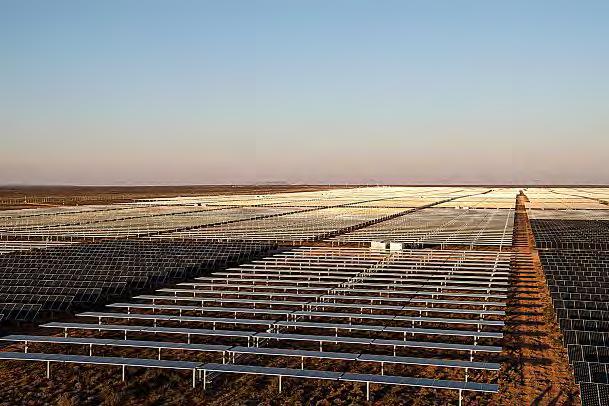
LAURENT ZYLBERMAN/GRAPHIX IMAGES/TOTAL
Administrative hurdles, poor infrastructure and the necessity for small-scale projects are all deterrents to the big players. That’s where partnerships come in
By PIERRE-OLIVIER ROUAUD
The oil majors are touting their global ambitions for renewable energy. France’s Total plans to invest $60bn in the sector within the next 10 years and is targeting 100GW of capacity on a global scale – that is 322 times the installed capacity of Africa’s largest wind farm at Kenya’s Lake Turkana. BP is targeting 30GW by the same date, while Shell has pledged to invest an annual $2bn-$3bn worldwide.
But, for the moment, the investment of the majors in renewables on the continent remains small. While Eni is promising solar projects in Egypt and Angola (Solenova, a joint project with Sonangol), it currently only has small photovoltaic plants in Tunisia, Algeria and Angola with less than 40MWp each in capacity.
Total operates in the solar sector through various subsidiaries, including Total Eren and the US company SunPower, which has developed the South African Prieska plant (86MWp). After Uganda in 2016 (10MWp in Soroti), Total Eren commissioned a 126MWp photovoltaic park near Aswan in Egypt in mid-2019. The group has also signed a contract with Greentech to build a 35MWp solar plant in Angola, and has developed industry-focused projects such as the IAMGOLD Essakane gold mine in Burkina Faso (15MWp). Shell is virtually absent from Africa as a project leader in renewables, as is BP, despite its 2018 partnership with Egypt’s Hassan Allam Utilities.
2030
Date on which Kenya’s Lake Turkana Wind Power Project is due to reach its full capacity of 310 MW.
Risks and red tape
“The majors take a global approach to carbon-emissions reduction and are focusing their transition efforts on developed and large emerging countries. Because of the structure of these economies and their energy mix, the impact is more rapid and massive than it would be in Africa,” says Francis Perrin, associate researcher at the Policy Center for the New South in Rabat.
A lack of will, or is it something else? The time it takes to set up projects in Africa and the poor electricity networks are obvious deterrents. In addition, there is the risk of cyclones to wind power in tropical areas, the lack of legislative frameworks in many countries, and ambiguity over land rights, which has proved a problem in Kenya.
Oil companies accustomed to mega-projects are ill-equipped to handle a multiplicity of small projects, microgrids or M-Kopastyle solar energy. “The future of electrification in Africa depends in part on decentralised renewable production. But the majors still have very little presence in this niche,” says Stéphane His of the Enerdata consultancy.
To speed things up, many of the companies are looking for partnerships. Through its foundation, Shell has provided $45m to a micro-electrification initiative supported by the US International Development Finance Corporation. In 2019, Shell and Japan’s Sumitomo bought a 15% stake in Powergen, a Kenyan microgrid developer. And Total has created Total Access To Energy Solutions (TATES) to develop pilot projects and support start-ups in East Africa.
EXPERTADVICE
66 avenue Marceau 75008 Paris - France Standard : + 33 1 53 57 70 70 rebecca.major@hsf.com
www.hsf.com
Green Energy in Africa: Accelerating energy transitions across the continent
International investors need to reduce their carbon footprint globally and are being pushed by market forces, legislators, courts and shareholders to do so.
Africa needs an «energy progression» as well as an «energy transition». In many parts of the African continent, it is not a question of chang ing the way electricity or transport networks are used, but a question of making reliable electricity supplies and transport networks available for the first time. Africa’s natural resources also need to be used to provide revenue for African citizens.
We think that the African continent can use the global «green b u s i n e s s revol u t i o n » to i t s advantage.
African governments and legislators can harness this green revolution to facilitate access to electricity for African populations and encourage exports that suit the needs of international investors. The challenge will be to find a happy balance in order to protect the African economic environment with a healthy level of exports, and the social and economic domestic environment with an energy progression.
There will be enormous investments in Europe in these areas in the next few years, by private companies, national governments and the European Union. African governments and African businesses need to position themselves now to capture some of these investments and encourage sustainable investment in the African energy sector going forward.
Some international companies are seeing Africa as a good testing ground for innovative t ec h n o l o g i e s a n d b u s i n e s s models. For example, we are seeing investments and potential investments from Europe (and elsewhere) into off-grid solar, battery storage, improved hydroelectric technology and various uses of blue and green hydrogen. Africa could become an attractive place for using
Rebecca Major,
Partner, Head of Energy and Natural Resources, Paris
technologies such as hydrogen and renewable sources to make existing and new natural resources projects greener and t h e re f o re mo re ma rket a b l e in the future. We have been talking to our clients about g re e n e r min es, greener ga s and LNG production, greener ammonia production and greener refining and beneficiation processes generally in Africa.
We hope to see African policy and legislation continue to evolve to take account of this game-changing revolution and look forward to continuing to advise international investors a n d g over n m e n t s o n t h e s e exciting challenges.
Kenya’s hot cuppa climate change
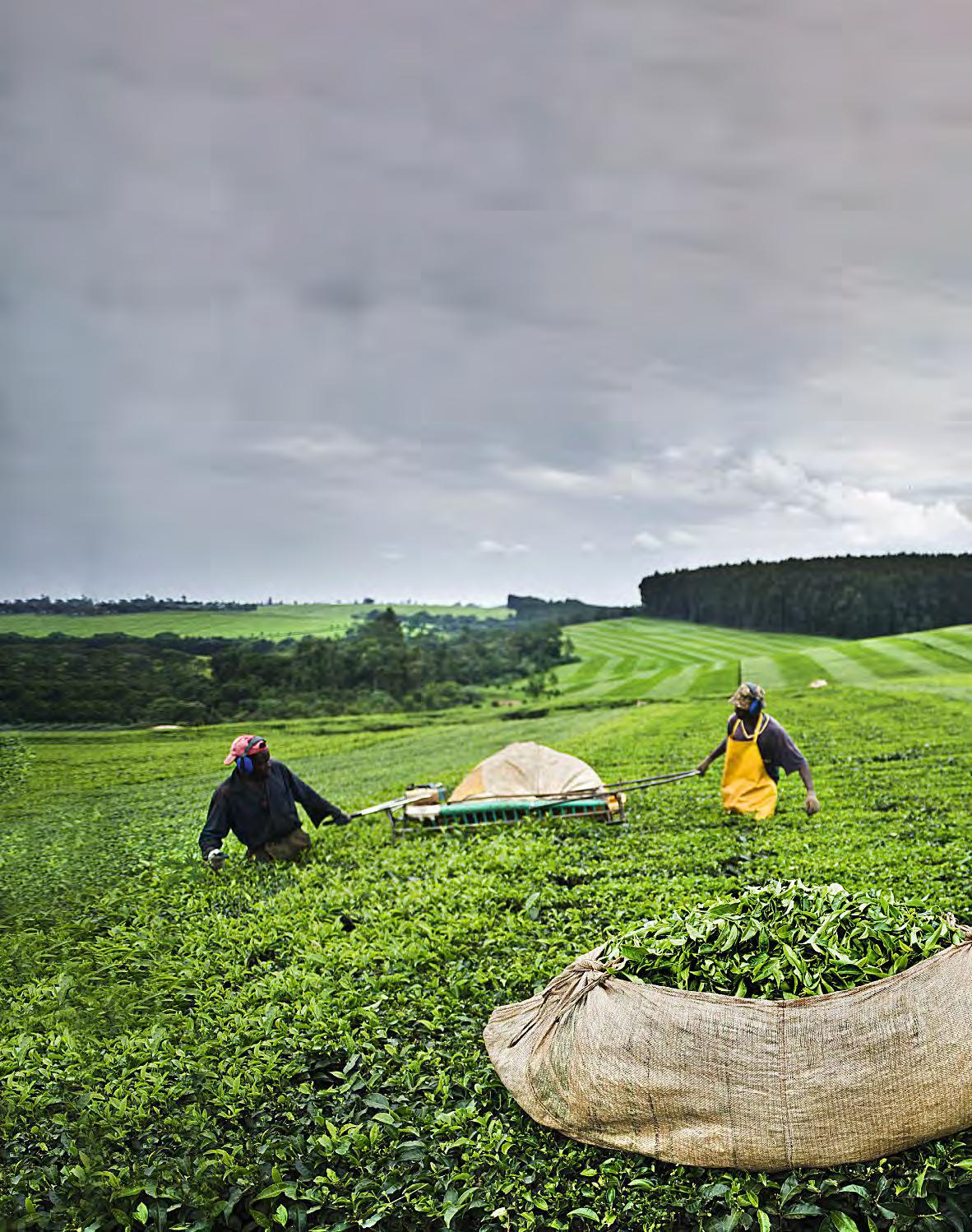
The optimum tea-growing areas in Kenya’s Rift Valley are shrinking
Activists and farmers warn that the sector needs to act fast before changes in temperature and weather patterns hit the leading black tea producer’s production hard
SVEN TORFINN/PANOS/REA

By VICTOR AMDALA in Kericho
“Twenty years ago, a visitor to Kericho would gladly ask for an extra blanket and not a swimming pool – especially at 6pm,” a guard at the Sunshine Hotel told me when I enquired about the possibility of taking a dip. Rolling a black button in his right hand, he laughed nervously for few seconds before launching into a lesson on the climatic history of the region: “I was born not far from here 62 years ago. The region was three times greener. Forests were thicker; you could barely see beyond two kilometres. Rain and cold was part of our lives. […] Now we have prolonged dry seasons and diminishing forest cover.”
It may have been a roundabout way of saying that the hotel didn’t have its own pool, but the man had given me a first-hand account of the changes affecting both smallholder tea farmers and multinationals in Kenya’s Rift Valley.
A recent study on the effects of climate change on the tea sector in Kenya by British charity Christian Aid confirms that the sector is facing a host of climate-related problems including rising temperatures, erratic rainfall, droughts and insect infestations. The authors forecast that by 2050 the rapid climate shifts will slash Kenya’s optimal tea-growing area by 26%. Mediumquality growing areas could also shrink by 39% in the next 30 years.
Kenya is highly vulnerable to climate change, with projections suggesting that its average annual temperature could rise by up to 2.5°C between 2000 and 2050. Going forward, rainfall will become more intense and less predictable. ‘Even the slightest increase in droughts will present major challenges for food security and water availability,’ the Christian Aid report warns.
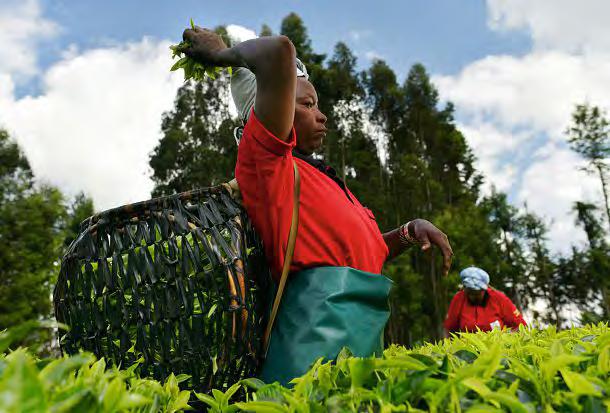
Trees conserve water
Another recent study, carried out by the United Nations Food and Agricultural Organisation for the Swedish International Development Cooperation Agency, surveyed 700 growers in Kenya’s seven major tea-growing regions. At least 40% of respondents said they had noticed changes in rainy and dry seasons, which had led to shifts in the planting season, while 35% cited drought.
These trends are worrying tea farmers. Some are considering uprooting the crop for short term alternatives such as maize, beans, potatoes and vegetables. Others are determined to keep growing tea, and are taking cues from large plantations that already have mitigation measures in place.
Ezekiel Kibet, one of 10,000 smallholder farmers working with the firm James Finlay in Kericho, told The Africa Report that he had cut all the eucalyptus trees down and planted indigenous trees across his fragmented four-hectare tea farm in Kipsolo village.
“There has been a slight decline in tea production due to erratic rainfall in this region. I have been growing tea for the past 40 years. The negative change in production which I have experienced in [the] past decade is a result of prolonged dry [weather],” Kibet said. Apart from tending to his own production, he religiously takes part in the community tree-planting session organised by James Finlay Kenya, which employs 7,000 people on its tea farms in Kericho.
Sammy Kirui, the corporate affairs manager at James Finlay, explains: “We plant at least 3,000 trees known for their waterconserving power around potential water sources. The company has noted unchecked dilapidation of indigenous Mau West Forest cover, which has been the source of rains that sustain multinational tea firms and smallholder farmers.”
The company’s approach combines precision agriculture, the use of biological energy in production and community involvement in conservation of forest cover. “Our plantation is on 7,000ha. We have maintained the forest cover within our area of operation. James Finlay takes responsibility for any tree felled within [that area],” Kirui says.
The largest plantation in the region, covering well over 10,000ha, belongs to Unilever Kenya, which has been working on reducing its carbon footprint. In 2018, Unilever East Africa partnered with fair-trade waste-management company Mr. Green Africa for a ‘U-Turn waste project’, creating a circular economy for its packaging materials by providing an end use for the recycled plastics.
Smallholders produce almost 60% of Kenya’s tea
FP / A TONY KARUMBA
600
TEA PRODUCTION IN KENYA
(in 1,000tn)
570.5
500
472 493
400
399.2 439.8 458.8
300
2015 2016 2017 2018 2019 2020
AT IONAL BUREAU OF ST AT ISTICS SOURCE: KENY A N
Clean cookstoves
More locally, the firm has supported the provision of ‘clean’ wood-burning cookstoves to tea-growing communities. The stoves are designed to replace the traditional smoky open fires, which cause air pollution and can lead to respiratory diseases. In addition, the tea processing plant in Kericho is now powered by a 619kWp solar park in partnership with CrossBoundary Energy, an investment fund that finances off-grid projects for companies.
The irony of rich nations’ profligacy affecting the very people who grow their basic foodstuffs is not lost on Unilever. In its 2019 sustainability report it said: ‘There has been an astronomical change in climatic patterns, not just in Kenya’s Rift Valley but everywhere in the world. While Africa is producing less carbon, the continent is highly impacted.’
Tailored support
The UK-based firm Twinings Tea, which works with smallholder farmers globally, including Kenya, calls its sustainability programme Sourced with Care. In addition to reducing its own carbon emissions with the target of being carbon neutral by 2030, it develops ‘tailored interventions’ in tea-growing communities by listening to the growers themselves.
Training on sustainable agricultural practices, women’s empowerment programmes and support for additional income-generating activities all increase farmers’ resilience in the face of climate change. According to Twinings Tea’s 2021 social impact report, Sourced with Care has reached up to 8,000 smallholder farmers in Kenya, and several tea centres have received international quality certification.
While the fact that large and multinational companies are taking social and environmental responsibility seriously can only be a good thing, local traders and environmental experts argue that the government must improve its environmental conservation policies.
Philip Rono, chairperson of Fintea Growers Cooperative Union, representing five cooperatives in Kericho and Bomet counties, says the state should come up with incentives or better policies to complement what farmers and multinationals are doing. “It makes no sense for multinationals to invest resources conserving the environment only for another firm to release its waste in water[ways] and go unpunished or [be] handled with baby gloves,” Rono says.
Some are considering uprooting the tea crop for short-term alternatives like maize
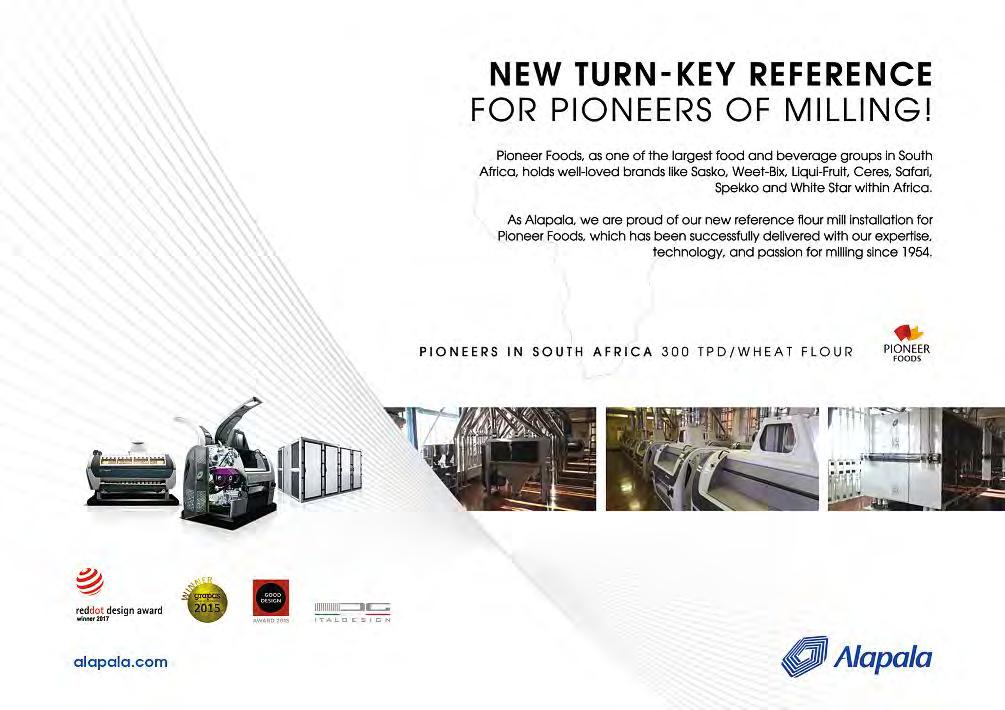


Africa – Fertile ground for the future of food security
It seems ironic that the world is pinning its food security hopes on a continent better known for famines and feeding schemes than for the abundance of fresh and nutritious produce. Yet, with around 25% of the world’s arable land, some say Africa has the potential to contribute to global food security. OCP Africa is set on growing that potential by literally working from the ground up and is playing a fundamental role in the transition of Africa’s farmers from subsistence farming to value-creating agriculture.
OCP Africa Extension Agent , Agripromoter programme.

On a long, dusty road in Kaduna State in north-western Nigeria, a bright green three-wheeler motorcycle, mounted with a square cargo box, buzzes along before turning off onto a track leading to a small settlement of modest houses and flourishing fields. This is an OCP Africa Extension Agent from the Agripromoter programme, just one of the programmes specially designed and run by OCP Africa to contribute to developing Africa’sintegrated agriculturalecosystems.
A subsidiary of OCP Group, the world’s largest phosphate mining and leading fertilizer company, OCP Africa has been on the ground and in the field for five years, gaining invaluable insights into smallholder farmers’ evolving needs while sharing lessons learned, strengthening cooperation, creating partnerships and developing solutions. It is well-positioned to provide advice, support, “best practices” and innovative agriculture through new technologies, thereby playing a role in achieving a green revolution in Africa, which goes way beyond its core business of supplying suitable fertilizers.
R&D isa strong component of OCP Africa’ssustainable agricultural development, integrated soil fertility management and climate change approach. It provides fertility mapping and soil analyses and develops new customised formulas adapted to specific soils and crops.
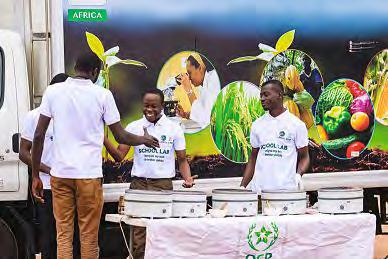
Mobile soil Laboratory, OCP School Lab.
Large-scale programmes for small-scale farmers
Africa’s smallholder farmers are the backbone of its agricultural sector and the focus of OCPAfrica’s projects and programmes which, since 2016, have benefited over a million farmers. With its African roots, tremendous agronomic knowledge, experience and agri-tech developments, OCP Africa’s large-scale programmes set out to impact not only the smallholder farmer but the entire value chain, with the aim of increasing yields and incomes. OCP Africa’s action is supporting small farmers through a wide range of partnerships, services and capacity building programmes to optimise their land’s potential so that they can thrive, favouring the development of ecosystems that lead to innovative financing, insuranceand markets, thereby securing farming activities and building the foundations for a sustainable future.
OCP Africa’s School Lab, one of the most innovative programmes, raises awareness about the importance of soil testing.A mobile soil laboratory travels to meet farmers where they are and, using the latest innovations (X-rays, big data, and machine learning) and real-time information on soil needs, helps them test their soil then makes free fertilizer application recommendations specifically for their soil and crop mix. School Lab also provides interactive training sessions with live demos on Good Agricultural Practices (GAP) and animated videos for higher impact. To date, School Lab has already helped over 420,000 African smallholder farmers across nine countries.
OCP Africa developed Agribooster, an inclusive development model that provides farmers with support at every step of the agricultural value chain. Agribooster focuses on the urgent need for African smallholder farmers to improve their productivity and yields, locate buyers and markets and access financial services, including loans. Through the Agribooster package, OCP Africa has so far provided around 630,000 farmers in four countries with access to quality products and inputs (fertilizers, plant protection products, hybrid seeds), technical and business training sessions, access to potential buyers on the market, personal support, and access to financial services (including loans).
Farmer House is a comprehensive last-mile distribution solution rolled out in Nigeria to address the availability and accessibility of agricultural inputs by bringing together all basic agricultural inputs, Good Agricultural Practices (GAP) training and extension services under one roof in proximity to smallholder farmers in rural communities. Each Farmer House is equipped with a classroom, a storage room, office space, a borehole well, one or more three-wheeler motorcycles, a digital soil analysis laboratory, a greenhouse, and a smart fertilizer blender, amongst others.

To reach smallholder farmers in their communities, each Farmer House employs one or more Agripromoters. These are OCP Africa extension agents, all equipped with a three-wheeler motorcycle mounted with a cargo box and a tablet that deliver agricultural inputs and training to farmers.
In the past five years, OCP Africa’s holistic, end-toend ecosystem and farmer-centric approach has empowered and improved the lives of African smallholder farmers.This was achieved under the strong conviction that Africa can become a world leader in sustainable farming and help feed its growing population and ultimately the world.

Good Agricultural Practices (GAP) training , Farmer House.
OCP AFRICA STRIVES TO:
Improve the fertility and productivity of African soils through appropriate products. Secure the production of competitive fertilizers near the largest farming areas. Contribute to the development of new local distribution networks, serving the entire agricultural sector. Improve farmers’ access to quality inputs, financing, markets, training and technology.
OCP School Lab +420 K African farmers trained in 9 countries Agribooster: 630 K farmers supported in 4 countries, >30% yield increase on average Farmer House: 29,250 smallholder farmers supported through 51 outlets in 18 states in Nigeria
Agripromoter: 7K smallholder farmers supplied and trained in Nigeria, 40K jobs to be created by 2040
EGYPT
Fresh orange exports are squeezing out other citrus crops
Producers say that the sector needs more diversification and processing in order to grow and protect farmers when there are major price swings
By SHERIF TAREK in Cairo
Having leapfrogged Spain, Egypt is steadily edging closer to achieving its full potential as the world’s top orange exporter. But that may eclipse opportunities to diversify into other high-quality citrus crops.
Since the 1980s, agricultural producers have increasingly channelled their resources into improving orange production, while pushing for the opening of new markets. Brazil and Japan have been added as export destinations in recent months. Oranges account for approximately 80% of Egypt’s total cultivated citrus area today, and according to official data, made up more than 86% of exported citrus fruit in the 2020/2021 season (December 2020 to 30 April 2021).
No more quantum leaps
The Foreign Agricultural Service (FAS) – a US Department of Agriculture agency – projects Egyptian orange production to rise by 6.2% year on year to reach 3.4m tonnes in the current marketing year (MY), which began last October. FAS Cairo also forecasts that orange exports will hit 1.5m tonnes in MY 2020/2021, up from 1.37m tonnes the previous year
More markets are set to open up, yet exporters are close to reaching saturation, says Hussein Marei, a board member of Egypt’s Horticultural Export Improvement Association and a managing partner at exporting company, the Egyptian Growers Organisation.
Hesham El-Naggar, CEO of the fresh fruit and vegetable producer Daltex, says that citrus exports will witness no more quantum leaps, only climbing marginally in the coming years, before plateauing in a decade. “We used to see increases of 20% or 15 % annually. Now we will be going up 2% or 3% at most,” El-Naggar tells The Africa Report.
Some producers worry that poor statistics are clouding a view of what is happening on the ground. They point out that official data does not reflect citrus oversupply, especially of oranges, because they are only based on agricultural plots that are registered at notary offices, Marei explains. Unregistered
Loading up in Beheira province, Egypt

parcels of land are mostly in the desert and were seized by farmers who invoked a law introduced by the late agriculture minister Youssef Wali, particularly during the 1980s and 1990s.
“A rough analysis indicated that while the government would say we produce 4m tonnes, [actual citrus production] “is closer to 6m tonnes,” Marei tells The Africa Report. According to projections based on similar analysis, “we are supposed to be producing anywhere from 6-8m [tonnes of citrus fruits],” which is significantly higher than Egypt’s domestic consumption and exported citrus fruits combined. This caused local prices to plummet in the past year, with losses incurred by producers, Marei says.
Valencia oranges, also known as summer oranges, are the most cultivated and exported citrus fruits in Egypt, comprising 60-70% of Egypt’s citrus production. Growing them is much less demanding than other citrus crops like mandarins, which require more technical know-how. Their harvest season extends from January to March or April, a period that corresponds to “a gap in the international market” – a prime opportunity for Egyptian exporters, Marei says.
Marei wants to see the sector strengthened through diversification. He is introducing new seedlings through his company, MAREI Orchard & Nursery. “I have been exhorting many growers not to cultivate the summer [oranges] anymore, and to plant mandarins, grapefruits and lemons to mix it up,” says Marei. Only then “will our reputation as citrus exporters” improve, he adds. El-Naggar agrees and says there is growing demand for citrus products, including grapefruits and lemons, which Egyptian exporters could tap into to beat fierce competition from Morocco, Israel and Turkey.
“Going industrial” could reduce the overabundance of Valencia oranges, which are widely used in juice production, says Marei. “There is a massive market in Asia and Europe,” he says. “There is potential in different areas […]. Dubai procures its juice products from the US and Poland and pays a lot of money for them. If they imported them from Egypt, they would be delivered faster and at a better cost.” Marei says Egypt has a head start in exporting not-from-concentrate (NFC) juices, which are fresh and pasteurised.
Unlike the concentrate, NFC juice can diminish in quality while being transported to far-flung destinations, and its price is higher due to its more costly transportation. Brazil is the main player in this sector, and Egypt could also be a strong NFC juice exporter to Asian countries.

AHMED GOMAA/XINHUA/REA 1.5m
tonnes of Egyptian orange exports are forecast for 2020-21, up from 1.37m tonnes in the 2019-20 season
Tariff-free trade
Khaled Medhat, from food and beverage company Döhler Egypt, says the country’s main advantage is its free-trade agreements as a member of the Common Market for Eastern and Southern Africa, the Greater Arab Free Trade Area and the EU-Egypt Association Agreement. Offering juice products that are cheaper than Brazil’s to countries that exempt Egyptian imports from customs would give Cairo a lead, he says.
Medhat says he would like to see a better system for regulating the relationship between farmers and juice makers to ensure sustainable procurements and fair prices: “The agro-industrial sector is not sponsored by a certain body in Egypt. There are no crops that are cultivated to be allocated for manufacturing,” he says. Egyptian fruit producers of all scales therefore primarily target fresh consumption, and juice makers receive what is left. What facilitates procurement for juice makers is that their specifications are less demanding than those of the fresh market, since they just need to focus on the internal quality of the oranges.
With orange prices fluctuating, a regulator should support either side when needed. “This already exists in Egypt for some items, such as raw milk, whose price is determined by the Egyptian Milk Producers Association,” Medhat says. “We always say we want contract farming in Egypt, but it can only be achieved with an arbitrator,” he concludes.







